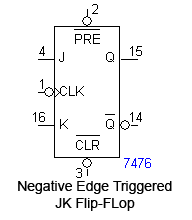


A JK flip-flop uses two inputs to direct state changes (the J input sets the output, and the K input resets the output if both are asserted, the output toggles between ‘1’ and ‘0’).In a DFF, the data input must be stable for a time immediately before and immediately after the clock edge.Flip-flop circuits are constructed in such a way as to make them operate properly when they are part of a sequential circuit that employs a single clock.The current output of a memory device is called the present state, and the input is called the next state because it will define the memory at the next assertion of the timing control input.All useful memory devices have at least two inputs one for the data signal to be memorized, and a timing control signal to define exactly when the Data signal should be memorized.Flip-flop with Asynchronous Reset always ( posedge(clk), posedge(rst))Įnd Flip-flop with Combinational Logic always ( posedge(clk), posedge(rst)) Figure 6 below illustrates JK and T flip-flops. The main attention has been in improving the performance of the circuits. Several flip-flops have been proposed in the literature. But they offer no advantages to designs built using programmable chips (like the FPGA used on the Blackboard). Double edge triggered flip-flops are edge sensitive devices which latch data in each clock period on rising and falling edge of the clock signal. These other flip-flops were commonly used in older digital systems (especially those built of discrete 7400 logic ICs) because their added features meant that fewer chips might be needed to construct a given circuit. Another device, the T flip-flop, simply toggled between ‘1’ and ‘0’ on each successive clock edge so long as the T input is asserted. For example, the JK flip-flop used two inputs to direct state changes: the J input set the output to a ‘1’ the K input reset the output to a ‘0’ and if both J and K were asserted simultaneously, the output toggled between ‘1’ and ‘0’. Over the years, other types of flip-flops were designed and used as well, but they were really just D flip-flops with some added features. The DFF is the simplest and most useful edge-triggered memory device, and it can be used in any application that requires a flip-flop.


 0 kommentar(er)
0 kommentar(er)
